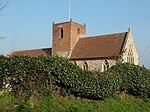Mutford and Lothingland Rural District

Mutford and Lothingland Rural District was a rural district within the administrative county of East Suffolk between 1894 and 1934. It was created out of the earlier Mutford and Lothingland rural sanitary district. It was named after the historic hundred of Mutford and Lothingland, whose boundaries it closely matched. In 1904 a new Oulton Broad Urban District was created out of parts of Carlton Colville and Oulton parishes. Oulton Broad UD was absorbed by the Municipal Borough of Lowestoft in 1919. In 1934, under a County Review Order, Mutford and Lothingland Rural District was abolished and its parishes transferred to the new Lothingland Rural District, apart from Gunton and some part parishes which were added to Lowestoft MB. In 1974 the area was divided between the new districts of Great Yarmouth (in Norfolk) and Waveney in Suffolk.
Excerpt from the Wikipedia article Mutford and Lothingland Rural District (License: CC BY-SA 3.0, Authors, Images).Mutford and Lothingland Rural District
Flixton Road, East Suffolk
Geographical coordinates (GPS) Address Nearby Places Show on map
Geographical coordinates (GPS)
| Latitude | Longitude |
|---|---|
| N 52.5 ° | E 1.7 ° |
Address
Flixton Road
Flixton Road
NR32 5PD East Suffolk
England, United Kingdom
Open on Google Maps







